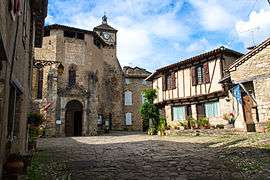Penne, Tarn
| Penne | ||
|---|---|---|
|
The centre of Penne | ||
| ||
 Penne | ||
|
Location within Midi-Pyrénées region  Penne | ||
| Coordinates: 44°04′41″N 1°43′52″E / 44.0781°N 1.7311°ECoordinates: 44°04′41″N 1°43′52″E / 44.0781°N 1.7311°E | ||
| Country | France | |
| Region | Languedoc-Roussillon-Midi-Pyrénées | |
| Department | Tarn | |
| Arrondissement | Albi | |
| Canton | Vaour | |
| Government | ||
| • Mayor (2008–2014) | Jean-Luc Kretz | |
| Area1 | 64.04 km2 (24.73 sq mi) | |
| Population (2006)2 | 557 | |
| • Density | 8.7/km2 (23/sq mi) | |
| INSEE/Postal code | 81206 / 81140 | |
| Elevation |
93–489 m (305–1,604 ft) (avg. 114 m or 374 ft) | |
|
1 French Land Register data, which excludes lakes, ponds, glaciers > 1 km² (0.386 sq mi or 247 acres) and river estuaries. 2 Population without double counting: residents of multiple communes (e.g., students and military personnel) only counted once. | ||
Penne (Occitan: Pena, meaning (large) feather) is a commune in the Tarn department in southern France.
History
Prehistory

The first traces of activity date back to the Bronze Age. In the middle of the 19th century, Jean-Baptiste Noulet explored a cave called Le Cuzoul d'Armand, and discovered several artifacts, including a bronze pearl necklace.
Middle-Age

The ancient village of Penne d’Albigeois is built on a mountain spur dominated by the ruins of a 12th-century fortress, hence its nickname, the “Vertigo Citadel”, or the “Impregnable”. This remarkable site, over the Aveyron, was highly strategic in the Middle-Age, though the fortress itself was relatively spared by the Albigensian Crusade.
Mentions of the castle of Penne can be found as early as the 11th century, when the local Lady was known to be an Albigensian, but the main towers date back to the 13th and 14th century. Remains include the dungeon, ramparts and a chapel.
See also
References
| Wikimedia Commons has media related to Penne, Tarn. |

.svg.png)